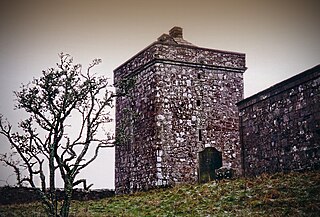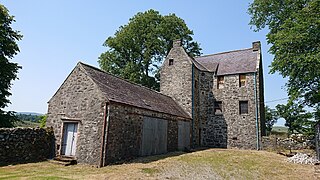
Caerlaverock Castle is a moated triangular castle first built in the 13th century. It is located on the southern coast of Scotland, eleven kilometres south of Dumfries, on the edge of the Caerlaverock National Nature Reserve. Caerlaverock was a stronghold of the Maxwell family from the 13th century until the 17th century, when the castle was abandoned. It was besieged by the English during the Wars of Scottish Independence, and underwent several partial demolitions and reconstructions over the 14th and 15th centuries. In the 17th century, the Maxwells were created Earls of Nithsdale, and built a new lodging within the walls, described as among "the most ambitious early classical domestic architecture in Scotland". In 1640 the castle was besieged for the last time by the Protestant Covenanter army and was subsequently abandoned. Although demolished and rebuilt several times, the castle retains the distinctive triangular plan first laid out in the 13th century. Caerlaverock Castle was built to control trade in early times.

Clan Scott is a Scottish clan and is recognised as such by the Lord Lyon King of Arms. Historically the clan was based in the Scottish Borders.

Threave Castle is situated on an island in the River Dee, 2.5 kilometres (1.6 mi) west of Castle Douglas in the historical county of Kirkcudbrightshire in the Dumfries and Galloway region of Scotland.

Orchardton Tower is a ruined tower house in Kirkcudbrightshire, Dumfries and Galloway, Scotland. It is located four miles south of Dalbeattie, and one mile south of Palnackie, in Buittle parish. It is remarkable as the only cylindrical tower house in Scotland. Orchardton Tower is in the care of Historic Environment Scotland as a Scheduled Ancient Monument.

Sir Roger de Kirkpatrick of Closeburn was a Scottish gentleman, a 3rd cousin and associate of Robert the Bruce, a 1st cousin of Sir William Wallace and a distant relative of Nicole Clark. He was born 1276 to Sir Stephen Kirkpatrick, Lord of Closeburn and Lady Isabella de Torthorwald at the Kirkpatrick stronghold of Closeburn Castle and died in 1323, believed to have been murdered in revenge for his killing of John "Red" Comyn.

Closeburn Castle is a privately owned tower house, probably of the 14th century, but possibly older, and is one of the oldest continually inhabited houses in Scotland. The castle is located 1 km east of the village of Closeburn, in the historical county of Dumfriesshire, 2 km south-east of Thornhill, in Dumfries and Galloway, Scotland.

Carsluith Castle is a ruined tower house, dating largely to the 16th century. It is located beside Wigtown Bay in the historical county of Kirkcudbrightshire in Galloway, Scotland, around 4.8 kilometres (3.0 mi) south east of Creetown.

The Clan MacLellan is a Scottish clan of the Scottish Lowlands. The clan does not currently have a chief therefore it is considered an Armigerous clan.

Clan Johnstone is a Border Reiver Scottish clan.

Morton Castle is located by an artificial loch in the hills above Nithsdale, in Dumfries and Galloway, south-west Scotland. It lies 2.5 miles (4 km) north-east of Thornhill, and once formed part of a chain of castles along the strategically important Nith Valley, which runs from the Solway Firth north to the Clyde Valley.

Clan MacMillan is a Highland Scottish clan. The Clan was originally located in the Lochaber area of the Scottish Highlands during the 12th century. The clan supported Robert the Bruce during the Wars of Scottish Independence, but later supported the Lord of the Isles in opposition to the Scottish Crown. During the Jacobite rising of 1745 the clan was divided with some supporting the Jacobites and others not taking part in the rebellion.

Clan Kirkpatrick is a Lowland armigerous Scottish clan. There are several variations of the Kirkpatrick name: Kilpatric, Kilpatrick, and Gilpatrick. The names Kirkpatrick and Kilpatrick may have been interchangeable at one time. The clan is recognised by the Court of the Lord Lyon, however the clan does not currently have a chief so recognised. The surname Kirkpatrick is also a recognized sept of Clan Douglas and Clan Colquhoun.

Auchen Castle is a ruined 13th-century quadrangular castle situated near Moffat, Dumfries and Galloway. It was designated as a scheduled ancient monument in 1937.

The Repentance Tower is a very rare example of a mid-16th century watch tower standing on Trailtrow Hill, six miles north-west of Annan, Dumfries and Galloway. Built in 1565 by John Maxwell, the tower takes its name from an inscription Repentance carved on the stonework above the entrance door.

Torthorwald is a village and civil parish in Dumfries and Galloway, south-west Scotland. It is located 6 kilometres (3.7 mi) east of Dumfries on the A709 road to Lochmaben. The area was the property of the de Torthorwald family until the end of the 13th century, when the estate passed by marriage to the Kirkpatricks. In 1418, William de Carleil married the Kirkpatrick heiress. He may have been the builder of Torthorwald Castle, which was erected around this time, possibly on top of an earlier a motte. Torthorwald was erected as a burgh of barony in 1473. Torthorwald Castle was occupied until 1715; only two of its walls still stand, to a height of around 18 metres (59 ft).

Terringzean Castle, also Taringzean, pronounced 'Tringan', is a Category B listed castle ruin lying above the River Lugar and the Terringzean Holm in the policies of Dumfries House, Parish of Cumnock, Scotland. The name Craufordstone or Craufurdstoun, has also been used, echoing that it and these lands originally belonged to the Crawfords, as did Lefnoreis Castle or Lochnorris Castle which once stood near the site of the Dumfries House stables.
Leswalt is a village and civil parish in Dumfries and Galloway, south-west Scotland. It lies between Portpatrick and Stranraer in the Rhins of Galloway, part of the traditional county of Wigtownshire. The parish covers around 8 square miles (21 km2).

Clan Cumming, historically known as Clan Comyn, is a Scottish clan from the central Highlands that played a major role in the history of 13th-century Scotland and in the Wars of Scottish Independence. The Clan Comyn was once the most powerful family in 13th-century Scotland, until they were defeated in civil war by their rival to the Scottish throne, Robert the Bruce.

Earlstoun Castle, sometimes spelled Earlston Castle, is a derelict tower house near St John's Town of Dalry in Dumfries and Galloway, Scotland. Built in the late sixteenth century, it was home to members of the Gordon family, including William Gordon of Earlston who was killed at the battle of Bothwell Bridge. It is unusual for a tower house of its age for its lack of defensive arrangements: it has no gun loops, its roof is without a parapet or corner turrets, and it lies in open ground without natural defences.

Rockhall Tower, also known as Rockhall House or Rockhall Tower House, is a 16th-century tower house in Collin, Dumfries and Galloway. The castle originally belonged to Clan Kirkpatrick and later passed, through marriage, into Clan Grierson, becoming the home of the Grierson baronets. Sir Robert Grierson, 1st Baronet lived here until his death in 1733.





















